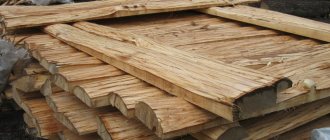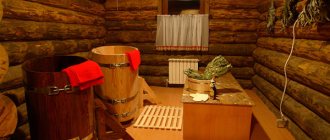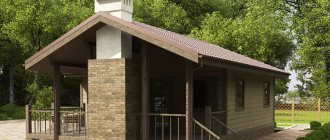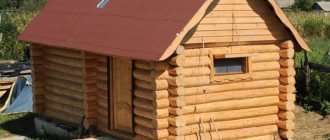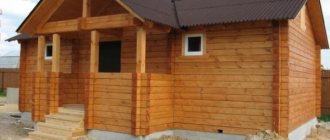Wood is often used to decorate bath rooms. It allows air to pass through, which allows the walls to “breathe”, and differs from other materials in its low thermal conductivity. Wood quickly deteriorates under the influence of temperature changes and high humidity. To protect the material, you need to know how to treat a steam room in a bathhouse.
Wood processing (Photo: Instagram / instroidom)
Types of buildings
Steam rooms that can be built on a summer cottage:
- Finnish saunas. The steam room should be dry, hot, with a minimum level of humidity and high temperature.
- Russian bath. Classic wooden building. The steam room has high humidity and moderate temperature.
Baths that are not built on summer cottages are Japanese ofuro and Turkish hammam. The Japanese bath does not have a steam room, which is filled with hot steam. The procedures are carried out in barrels of water heated to a certain temperature. A Turkish hammam has a high level of humidity and low temperature.
Painting the stove
In addition to deciding what is the best way to paint the inside of the bathhouse, you should also take care of the design of the stove. As a result, this element of the steam room will not only provide warmth, but also serve as a beautiful interior detail.
Of course, the best option would be to use special enamels that can withstand temperatures up to + 600 o C. If this option does not suit you for aesthetic or economic reasons, the stove can be decorated in the old Russian style - whitewashed with chalk or lime.
Regardless of the material chosen, the surface must be prepared accordingly. The surface should be thoroughly plastered, getting rid of minor defects, irregularities and potholes. As a last resort, treat the seams between the bricks with a special clay mortar.
The stove in the bathhouse can be whitened with chalk or lime
Note! The material for plastering is a solution consisting of asbestos and clay, which is applied to a hot surface (the oven must be well heated). Whitewashing or painting should begin after the oven has cooled and the solution has hardened.
Whitewashing with chalk
To do this you need to prepare a special solution:
- Place pieces of chalk in a bucket, fill them with water and leave for an hour.
- In a separate container, mix animal glue and water in proportions of 25:1.
- Combine both solutions and mix until a homogeneous composition is obtained.
To make the surface look more aesthetically pleasing, you can apply two layers. The next one is applied only after the previous one has completely dried.
Lime whitewash
You can prepare a solution from 1 kg of lime (slaked) mixed with 1.5 liters of water. You can add one teaspoon of drying oil, 25 grams of blue and a pinch of salt. This will give the whitewash an attractive bluish tint.
Why carry out processing?
Bath treatment is carried out to solve several problems:
- protecting lumber from moisture;
- changes in the external design of wooden surfaces;
- protecting wood from the appearance of fungus, mold, and dirt.
There are also compositions to protect wood from fire.
Mold on wooden boards (Photo: Instagram / dachamecht)
Requirements for protective compounds
Requirements for funds:
- Resistant to moisture and temperature changes.
- Immunity to mold and mildew formation
- Preservation of the natural shade of wood, if the products are not intended to change the surface design.
The protective composition should not emit harmful substances during operation.
Applying a protective composition (Photo: Instagram / flaxoilwood)
Types of protective compounds
Types of funds:
- Waxy, oily substances. Effectively displaces water from wooden surfaces. They have a specific odor that appears when heated.
- Water soluble. After their application, a dense film is formed on the surfaces, which protects the material from moisture.
- Antiseptics for wood. They are used as a fungicide that destroys pathogenic bacteria and pathogenic microflora.
- Decorative coatings. Varnishes that are made on an organic basis.
The specifics of the product, its purpose, and place of application are indicated on the packaging.
Oils
There are different types of oils for wood processing - tung, linseed, tar, teak. Such compositions are easy to apply to surfaces. They do not emit harmful substances during operation. With their help you can restore damaged wooden surfaces.
Oil and wax for baths (Photo: Instagram / maslo_zhivica)
Impregnations
Kinds:
- Salt based. They can protect wood from fire or mold and mildew. Similar compositions are used when treating non-residential premises. They are a powder that must be diluted with water before use.
- Non-salt impregnations made on a water basis. Fire retardant compounds for wood processing. Suitable for work indoors and outdoors.
Lucky
The internal surfaces of the steam room cannot be coated with regular varnish. It heats up quickly, begins to crack, and crumbles. When exposed to high heat, varnished surfaces emit harmful substances.
To make the coating durable, you need to use special compounds - acrylic varnishes. Such compositions can withstand heating above 120°C.
Applying varnish (Photo: Instagram / _eco_steam_)
Wax
Made from three components:
- solvent;
- carnauba wax;
- paraffin or beeswax.
Wax for impregnating wood penetrates deeply into the material, repels moisture and dirt. The products are safe because they do not emit harmful substances during use.
How to treat the inside of a bathhouse to protect it from an aggressive environment
Wood is the best material for building a bathhouse, its interior decoration and making the necessary furniture. Thanks to low thermal conductivity, environmental friendliness and attractive appearance. But the heat and high humidity inherent in the inside of the steam room have a very detrimental effect on the wood.
Therefore, it is worth thinking about how to treat the inside of the bathhouse to extend its service life.
Photo of the steam room after processing the interior lining
General provisions
Many people believe that correct installation of all building elements, proper ventilation and the use of only high-quality tree species can prevent adverse effects on the walls of the steam room. And this is better than treating the walls in the bathhouse with some kind of antiseptic, since there will be no danger of the enzymes in the solution evaporating into the air at high temperatures.
Do-it-yourself ventilation arrangement
Absolutely right. Good air movement can overcome dampness in the bathhouse and prevent mold and fungi from developing from the inside. But this is not the only problem.
It is also possible:
- The effect of “warping” of boards due to constant exposure to high temperatures. The most vulnerable finishes are on the ceiling and near the stove.
- Darkening and contamination of the wood surface with frequent use, making the interior look like the inside of a “black” bathhouse. This is especially true for shelves.
Type of “black” bath
- Pest attack. External timber walls are also susceptible to this.
- Stagnation of dampness in the absence of ventilation or an error in its design.
Thus, we can come to the conclusion that processing is still necessary in most cases. It will definitely be able to extend the life not only of the interior lining of the bathhouse, but also of the wooden walls outside the building.
Moreover, current solutions:
- Environmentally friendly even at very high temperatures.
- Heat resistant.
- Excellent protection from dirt.
- Drive away possible pests.
- Increases the strength of the material.
Let's consider the recommended compositions for various elements of baths and saunas.
You should not treat all surfaces of the building with the same solution. You should proceed from the proximity of the product coated with the protective composition to the person during the bath. So, for example, when choosing what to treat the lower rims of a bathhouse with, there is no point in overpaying for an expensive and harmless composition, because they do not come into contact with people.
Principles and features of do-it-yourself processing
Recommendations for treating surfaces in a bathhouse with your own hands:
- Processing of lining should be carried out in cool weather, but the air temperature should not be lower than 5°C.
- Before applying a protective agent to the finishing material, it is recommended to use it on a test piece of lumber to see and evaluate the result.
- Before applying the composition, you need to study the instructions for its use. It is indicated on the back of the package.
- When processing, you need to pay special attention to the processing of the ends of lumber, since they are destroyed the fastest.
- To wash your hands from impregnation, it is better to use vegetable oil.
Uneven surfaces can be covered with a special wood putty.
Lining in the steam room (Photo: Instagram / vagonka.kz)
Selection of protective compounds and tools
Principles for choosing a protective composition for wood:
- If you have enough funds, it is better to use universal impregnations that simultaneously protect the wood from various aggressive factors.
- The choice of impregnation depends on the type of wood with which the bath rooms are sheathed. Some of them have natural protection from external factors, others require additional processing.
- The product must withstand heating up to 100°C.
If the wood has been damaged by fungus, mold, or has begun to rot, you need to completely replace individual boards or use strong impregnations.
Tools, consumables for work:
- Brushes of different sizes.
- Roller, flat container for protective composition.
- Film to protect surrounding surfaces from impregnation.
- Solvent, sponge.
- Standard protective equipment - glasses, respirator, gloves, long sleeves.
- Construction trestles (wooden scaffolding). It is easier to lay lumber on them during processing.
It is better to use a spray gun to apply the protective agent. If it is not available, it is recommended to use a spray bottle to treat plants against pests. After coating the wood with impregnation, the spray bottle and tube must be rinsed to remove any remaining chemical liquid.
Rollers (Photo: Instagram / udarnik_stroybaza)
Preparation
Before starting surface treatment you need to prepare:
- Caulk the cracks between the beams so that heat does not escape from the premises.
- Sand rough edges with sandpaper or a grinding machine. It is recommended to wet the wood to reveal areas of flaking in the wood.
- Sweep away debris and wood dust with a broom or soft brush.
It is recommended to mix 10 liters of water with 300 grams of soda and wipe the wooden surfaces with a damp sponge.
Carrying out work
Features of work in different rooms:
- In the steam room. To treat wooden surfaces in this room, you cannot use chemical compounds or standard varnishes. They will release harmful substances when heated strongly. The coating will quickly collapse and become unusable. Therefore, you need to use compounds that will not emit harmful substances - wax, acrylic varnishes, decorative impregnations.
- In the shower. In this room, surfaces are exposed to intense moisture. Therefore, they must be reliably protected from its penetration inside. For impregnation, it is better to use wax compounds, since they are deeply absorbed into the wood and repel moisture and dirt from surfaces.
- In the rest room. For the dressing room, you can choose any impregnation, since in this room the material is exposed to a minimum amount of aggressive factors. Typically, colored stains are chosen to protect surfaces in the dressing room.
- In a swimming pool. For a room with a swimming pool, the requirements for choosing a protective agent are the same as in a shower room.
You also need to pay attention to the processing of the shelves in the steam room. For furniture on which bathhouse visitors will sit or lie, you need to choose compounds that protect the wood from moisture and dirt absorption. It is forbidden to coat them with varnish. The best options are special wax compositions or oils for steam rooms.
Swimming pool (Photo: Instagram / sauna_akshaule2020)
Sequence of work
At the first stage, a wooden frame is made, to which the seat boards will then be attached. To do this, you will need a beam with a cross-sectional size, for example, 50x70 mm. The height of the beam depends on the height of the ceilings in the steam room. With a height of 2.35 m, you can prepare beams with a height of 1.09 m. The number of racks will directly depend on the width of the wall near which the shelves are installed. With a wall width of 3 m, ten beams will be enough.
The beams near the longer wall are installed in pairs and fastened with two sections of beams with the same cross-sectional size. The length of the upper transverse beam can be made 0.69 m, the lower one, placed at a height of approximately 0.55 m from the floor, can be 1 m. We connect the lower beam with an additional vertical beam 0.55 m high. The lower shelf will rest on it. To attach the bars to the posts, you must use two strong self-tapping screws.
The frame for the part installed along the smaller side is made in almost the same way. However, the height of the racks is taken equal to the height of the additional rack (0.55 m). the racks are connected to each other by beams with the same cross-sectional size, but 0.4 m long.
After the frame is made, the flooring is attached. To do this, take boards whose length corresponds to the length of the wall along which the shelves will stand. If the walls of the bathhouse are planned to be covered with clapboard, it is worth providing an additional gap near the walls. The boards must be laid with a gap of 1 to 2 cm. It is preferable to use oak wedges as fasteners, providing special holes for them in the places where the elements are sewn together. It is better to avoid using all kinds of metal nails and screws, since there is a high probability that the heated metal will burn the skin during a visit to the steam room.
If you decide to use self-tapping screws to attach the decking, you need to make sure that their heads are “recessed” into the wood. In this case, the distance from the surface to the screw head must be at least 5 mm. This will reduce the likelihood of skin contact with heated metal while a person is in the steam room.
To prevent injuries while visiting the steam room, the distance between the upper and lower shelves should be covered with boards. However, you should not sew up the space between the floor and the bottom shelf. This will provide the necessary ventilation. The shelves will dry out faster, and cleaning the steam room will be much easier. After the work is completed, it is necessary to sand the boards, smoothing the corners. to the begining
Surface care
In order for the surfaces in the bathhouse to retain their natural color for a long time and not be destroyed by moisture, you need to:
- After performing bath procedures, wipe the shelves and walls from residual moisture with a dry towel.
- Collect leaves that fall from bath brooms. If they get stuck in the cracks between the boards, the wood will rot faster.
- Before wiping, rinse the shelves with cold water.
- Carry out general cleaning of the bathhouse twice a month. You can remove dirt with a strong stream of water. This makes it easier to clean out dirt that accumulates between the boards. When carrying out general cleaning, you can use weak detergent compositions.
- Ventilate the premises after bathing procedures.
- Clean ventilation openings regularly.
To get rid of unpleasant odors in a steam room or shower, it is recommended to use detergents that have antibacterial properties. They need to be applied to the surface for 40 minutes, rinse with cool water.
To ensure that the air in the waiting room, shower, and steam room always remains pleasant and clean, it is recommended to use deodorizing essential aromatic oils. Such compositions cannot be used for pouring hot stones in a heater.
Treating wooden surfaces in a bathhouse with special protective compounds is a mandatory procedure necessary to extend the durability of finishing materials. Without additional processing, the wood will quickly darken, become covered with mold, mildew, and gradually deteriorate. When choosing a product, you need to take into account that the impregnation should not emit harmful substances.
Choosing material
It is immediately worth noting that in this case only natural materials can be used. You should immediately stop using plastics and especially metal. In fact, the only suitable material in this case is wood. However, it must be of high quality.
Bath shelves should be made exclusively from those types of trees that have low thermal conductivity, have a significant fiber density and contain a small amount of resin. In addition, they should be characterized by heat and moisture resistance. It is best if the shelves are made of aspen, abashi, linden, birch, poplar.
Linden, which has numerous beneficial properties, will provide a delicate aroma in the steam room. Linden boards are easy to process, have virtually no knots, heat up fairly slowly, and dry quickly. Such shelves will contribute to the health of the body for a long time, but may darken over time. Aspen boards can also have a healing effect on humans. However, shelves made from this material may begin to deteriorate from the inside over time. Although this will not be noticeable from the outside.
Abashi, delivered from Africa, also has a wide range of beneficial properties. Such material warms up so slowly that it is simply impossible to get burned on such boards. At the same time, throughout the entire period of operation, it retains its color unchanged. Although the high cost of abashi significantly reduces the volume of its use.
In addition to the above-mentioned wood, black or ordinary alder and maple can also be used. Alder is resistant to deformation. Able to withstand high temperature exposure. Characterized by a fine and uniform structure. At the same time, black alder has a darker surface.
The use of coniferous wood should be abandoned. During operation, they can release resin under the influence of high temperature. In the most exceptional cases, they can be used to make stands that cannot be touched by humans. However, this will reduce the durability of the structure as a whole, since it is desirable that all elements are made of the same material. to the begining
The shelves inside the steam room can be located in different ways. Most often there is an “L”-shaped, stepped arrangement or in a “coupe” shape. Stepped placement involves the presence of three steps, each of which is designed for a different temperature: the hottest will be on the top, coolest on the bottom. This is the best option for large spacious rooms.
The “L”-shaped type also provides for the presence of three shelves. In this case, the upper and lower ones are located against one wall, and the middle one is located against the adjacent one. The coupe type is ideal for small double rooms. In this case, two shelves are installed: upper and lower. Moreover, the top one is folding. It can always be lifted and mounted on the wall, thereby saving the small space available.
